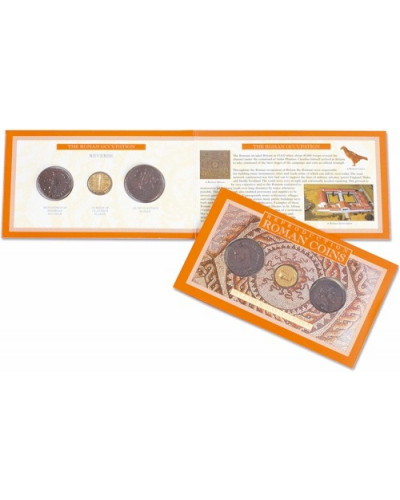Roman Coin Set 4 - The Roman Occupation
- Product Code: RCP4
- Availability: In Stock
- Pack Qty: 10
Product Description: These reproduction As of Claudius, Aureus of Claudius and Dupondius of Hadrian coins are moulded directly from original coins and are made from pewter. The gold aureus is 22ct gold plated and the As and Dupondius are bronze finished. The pamphlet style packaging has holes on the front in which the coins are held in clear blisters. The coin pack has an image of a Roman mosaic on the front and further Roman images inside. The pack includes information about the Roman occupation of Britain and Hadrian’s Wall.
Information: The Romans invaded Britain in 43AD when about 40,000 troops crossed the channel under the command of Aulus Plautius. Claudius himself arrived in Britain to take command of the later stages of the campaign and earn an official triumph.
Throughout the Roman occupation of Britain the Romans were responsible for building many monuments, cities and roads, some of which can still be seen today. The road network constructed was first laid out to support the lines of military advance across England, Wales and finally Scotland. The roads were very straight and continually needed repairing. This proved to be very expensive and so the Romans continued to manoeuvre large heavy loads over long distances by water whenever possible. This road network also enabled provisions and supplies to be moved quickly and efficiently. Consequently many settlements, villages and civitas (capital cities) grew. In the civitas many public buildings were built such as forums, bath houses and amphitheatres. Examples of these Roman remains can be seen today like the Roman Theatre in St. Albans (Verulamium). Shops were always numerous in the centre of a settlement like a market, providing services for the towns own inhabitants and neighbouring countryside. Butchers, wine merchants and blacksmiths were commonplace.
Hadrian became emperor in 117AD after the death of Trajan and set about implementing significant changes which marked a turning point in both Roman and European history. His new policy aimed to consolidate the frontiers and restore order which was in itself difficult for there were many who questioned Hadrian’s succession as, during the second century, emperors nominated their own successors. There were suspicions that Trajan had not named Hadrian, causing discontent among the late emperor’s senior generals. An alleged conspiracy was promptly quashed by the senate ordering the execution of those involved.
Evidence of Hadrian’s strengthening and consolidation can be seen between Wallsend and the river Tyne to Bowness on the Solway. Hadrian’s Wall took fifteen years to complete, spanning some 73 miles, and was approximately 10 foot wide and 15 foot high. This fortified frontier had fortresses at regular intervals. Between the forts were Mile Castles (fortified turrets). Substantial remains can still be seen including forts at Chesters, Homesteads, Carvoran and Birdoswald. Whether used as a barrier intended to control the native population or as a lasting memorial to Rome’s most northerly point, Hadrian’s Wall is regarded as one of the finest examples of achievement and has provided historians with an abundance of evidence enabling us to have a clear understanding of the Roman occupation.
Tags: Coin Set, The Roman Occupation, Claudius, Hadrian, Coin Pack, Gold Plated, Bronze, Roman

